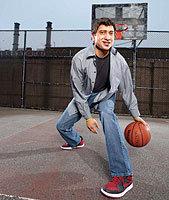|

Vasu Kulkarni photograph by David
Yellen Photography
|
|
For the Stats of the Game
|
|
Kulkarni’s company makes software that synchronizes game logs with video footage to create a database that coaches and players can use to analyze their games
|
|
By Kaitlin Mcvey
|
Vasu Kulkarni became a basketball junkie at the age of 4 when he was living in Los Angeles and watched the NBA finals for the first time. Soon after the 1994 earthquake, his family moved back to India to introduce him to his native culture. Living in Bangalore was difficult at first, being the “kid with the funny accent,” but he soon learned to adjust and began playing basketball on his school’s court that consisted of a dirt floor and a wooden backboard. “Back in ’95 it wasn’t the easiest game to play because everyone loved cricket,” Kulkarni says. He pursued his passion by playing on club teams. After graduating from high school, he went to the University of Pennsylvania in Philadelphia, where he tried out for its basketball team.
At 5 feet 10 inches and 61 kilograms, he soon realized that “there was a large discrepancy” between him and the other players. “I always wondered whether I had the confidence to play because Indian guys aren’t big,” he says. Kulkarni worked out and bulked up until his senior year as a walk on—someone without an athletic scholarship—and made the Junior Varsity team.
While playing on the team, his coach gave him an astute suggestion: “Why don’t you look into basketball stats?” After observing the stats taken during each game, Kulkarni was positive that technology could better capture and analyze information for the player’s benefit. After graduating with a computer and telecommunication engineering and entrepreneurship degree, he began reaching out to contacts in India. Kulkarni worked at a daytime consulting job until the programmers he employed were able to create an affordable software package. With the prototype and a $50,000 investment from a friend in hand, Kulkarni launched Krossover Intelligence in November 2008.
Based in New York City, the company focuses on the online video search industry. The software synchronizes game logs with video footage to create a database that coaches and players can use to review plays and analyze their games. Kulkarni describes Krossover as an “online database of indexed sports video content that not only allows coaches and athletes to enhance their level of play through data analysis, but also serves as a storage of memories—for 90 percent of athletes, their high school and college days are the best days of their lives—and will be the highest level at which they will ever compete.”
Kulkarni was initially nervous about how an Indian would be accepted into the sport’s world and considered “getting someone else to be the face of the company.” But he realized that his passion for basketball would always shine through and erase any doubts about his commitment to his product and the game. He also thought that being just 22 years old might be a problem in securing investors. However, this wasn’t an issue since people are “used to seeing young guys at the forefront of the tech industry. At the end of the day, if they think they will deliver, it works.”
Living in both the United States and India gave him a strong advantage when starting his company. “Moving from the U.S. to India, where everything was different, allowed me to understand that you can’t always get what you want.” Besides the life experience, India also provided him with crucial connections. He now has offices in India and admits that he doesn’t know whether he would have created Krossover if he hadn’t lived there. “It shaped the business in a large way.”
Krossover now offers both basketball and lacrosse platforms to its customers and it has soccer, volleyball and tennis coming out this year. “We currently have close to 350 teams that are paying customers, and several hundred more in the pipeline. We are capping the number of basketball teams for this season at 500, the rest go on a wait list, and will expand next basketball season to possibly 1000 to 1500 teams.”
Kulkarni’s dream is to “be the first Indian to have the majority ownership in an NBA team.” The company is heading in this direction since it “grew revenues by 500 percent [in 2011] as compared to last, and our target for [2012] is to once again grow at 500 percent.”
Kulkarni’s advice to aspiring entrepreneurs: “Remember, you miss 100 percent of the shots that you don’t take!”
—Courtesy SPAN
|
|
|
|
|
|
|
|
|
|
March 2012
|
|


|
|
|
|